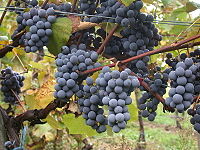Gamay Noir
| Gamay | |
|---|---|
| Grape (Vitis) | |
 |
|
| Colour of berry skin | Black |
| Also called | Gamay Noir à Jus Blanc |
| Notable regions | Beaujolais, Loire Valley; Niagara Peninsula; Willamette Valley |
| Notable wines | Bourgogne Passe-Tout-Grains, Beaujolais nouveau |
Gamay is a purple-colored grape variety used to make red wines, most notably grown in Beaujolais and in the Loire Valley around Tours. Its full name is Gamay Noir à Jus Blanc. It is a very old cultivar, mentioned as long ago as the 15th century. It has been often cultivated because it makes for abundant production; however, it can produce wines of distinction when planted on acidic soils, which help to soften the grape's naturally high acidity.
The Gamay grape is thought to have appeared first in the village of the Gamay, south of Beaune, in the 1360s. The grape brought relief to the village growers following the decline of the Black Death. In contrast to the Pinot noir variety, Gamay ripened two weeks earlier and was less difficult to cultivate. It also produced a strong, fruitier wine in a much larger abundance.
In July 1395, the Duke of Burgundy Philippe the Bold outlawed the cultivation of the grape, referring to it as the "disloyal Gaamez" that in spite of its ability to grow in abundance was full of "very great and horrible harshness", due in part to the variety's occupation of land that could be used for the more "elegant" Pinot Noir. Sixty years later Philippe the Good issued another edict against Gamay in which he stated the reasoning for the ban is that "The Dukes of Burgundy are known as the lords of the best wines in Christendom. We will maintain our reputation".
Gamay is a very vigorous vine which tends not to root very deeply on alkaline soils resulting in pronounced hydrological stress on the vines over the growing season with a correspondingly high level of acidity in the grapes. The acidity is softened through carbonic maceration, a process that also allows the vibrant youthful fruit expressions reminiscent of bright crushed strawberries and raspberries, as well as deep floral notes of lilac and violets.
Gamay-based wines are typically light bodied and fruity. Wines meant to be drunk after some modest aging tend to have more body and are produced by whole-berry maceration. The latter are produced mostly in the designated 'Cru Beaujolais' areas where the wines typically have the flavor of sour cherries, black pepper, and dried berry, as well as fresh-cut stone and chalk.
...
Wikipedia
